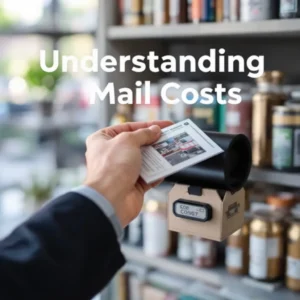When you think about direct mail, it’s easy to overlook the costs and benefits that come with it. Understanding what you’ll spend—like mailing lists, postage, and design—can make or break your campaign. But the real question is how these costs translate into tangible results. As you explore this topic, you’ll discover strategies that can elevate your marketing efforts beyond the basics. What’s the secret to maximizing your ROI?
The Evolution of Direct Mail Marketing
As direct mail marketing has evolved over the years, it’s clear that this traditional method has adapted to meet changing consumer preferences and technological advancements.
You’ve likely noticed how direct mail campaigns now include personalized content and targeted mailing lists, making them more relevant to you. With data analytics, businesses can pinpoint exactly who to reach, increasing the effectiveness of each marketing campaign.
Additionally, advancements in printing technology and postage options have made it easier and more affordable to produce eye-catching mailings.
This evolution means direct mail isn’t just a relic of the past; it’s a dynamic tool that, when used strategically, can deliver impressive results and drive engagement in today’s competitive market.
The Importance of Direct Mail in Today’s Marketing Landscape
While digital marketing often dominates discussions about effective strategies, direct mail remains an essential player in today’s marketing landscape. Incorporating direct mail into your marketing strategy can enhance your campaign’s effectiveness, allowing you to reach audiences tangibly.
A well-designed postcard or brochure can capture attention, providing essential information that digital formats sometimes miss. People often appreciate receiving a personalized mailer, which can create a lasting impression and boost engagement.
Additionally, direct mail allows for targeted outreach, ensuring your message reaches potential customers who are more likely to respond. Emphasizing the unique benefits of direct mail alongside digital efforts can create a thorough marketing strategy that truly resonates with your audience, ultimately driving better results for your campaign.
Types of Direct Mail Campaigns
Direct mail campaigns come in various forms, each designed to achieve specific marketing goals. One popular type is the flyer, which provides concise information about your products or services. Flyers can be colorful and eye-catching, making them effective for promotions.
Another option is direct postal mail, where you send personalized letters or postcards to your target audience. This approach can create a more personal connection and increase response rates.
You might also consider catalogs, which showcase your entire product range, enticing customers to explore more.
Finally, brochures offer detailed information and can be placed directly in a customer’s mailbox, helping them remember your brand. Each type has its unique advantages, so choose what aligns best with your marketing objectives.
Understanding Direct Mail Costs

Understanding the costs associated with direct mail is essential for maximizing your marketing budget. When you plan a direct mail campaign, consider several factors that contribute to the overall expense.
First, you’ll need to account for the mailing list, as purchasing or renting quality lists can impact your budget considerably.
Next, think about postage rates, which vary based on size and weight. Additionally, there’s the cost of design and production, including any graphic design services you might require.
Don’t forget about fulfillment costs, like packing and handling, which can add up quickly.
Printing Costs: Factors to Consider
When planning your direct mail campaign, printing costs can greatly impact your overall budget. Several factors influence these costs, beginning with the type of material you choose. Higher-quality paper or specialty finishes can increase expenses but may enhance your message’s appeal.
Additionally, consider the quantity of pieces you’ll print; larger runs often reduce the cost per unit due to economies of scale. Color versus black-and-white printing also plays a significant role in pricing.
Don’t forget to account for additional services like folding, cutting, or addressing. Finally, it’s wise to get quotes from multiple printers to compare rates and services.
Design and Creative Expenses
While effective design can greatly enhance your direct mail campaign, it often comes with its own set of expenses. Hiring a professional designer can be a significant investment, but their expertise can guarantee that your materials stand out.
You’ll also want to take into account costs for graphic design software or stock images if you’re handling the design in-house. Additionally, creating compelling copy that resonates with your audience might require a skilled copywriter, adding to your overall budget.
Don’t forget about the costs associated with revisions and adjustments; these can quickly add up. Ultimately, investing in quality design can lead to higher engagement rates and better returns, making it a vital aspect of your direct mail strategy.
List Acquisition and Targeting Costs
Quality design captures attention, but the effectiveness of your direct mail campaign also hinges on who receives it. List acquisition and targeting costs can greatly impact your overall budget.
You’ll want to invest in high-quality mailing lists that align with your target audience. This means researching demographic, geographic, and psychographic data to confirm you’re reaching the right people.
You can either purchase lists from reputable providers or build your own through customer data. While buying lists incurs an upfront cost, it can save time and effort.
Don’t forget to reflect on the ongoing maintenance of your lists; keeping them updated is vital for maximizing your campaign’s effectiveness.
Ultimately, targeting the right audience can lead to higher response rates and better returns on your investment.
Postage Fees: What You Need to Know
Have you considered how postage fees can impact your direct mail budget? These fees can greatly affect your overall costs, so it’s important to understand the different rates and options available.
The U.S. Postal Service offers various pricing tiers based on size, weight, and delivery speed. For instance, First-Class Mail is quicker but pricier than Standard Mail, which is a more economical option for bulk mailings.
You can also benefit from shipping discounts if you pre-sort your mail. Don’t forget to factor in additional charges for special services, like tracking or certified delivery.
Labor and Fulfillment Costs
Postage fees are just one piece of the direct mail puzzle; labor and fulfillment costs also play a significant role in your overall budget.
When planning your campaign, consider the expenses tied to assembling, addressing, and packaging your mailings. You’ll need a reliable team to handle these tasks efficiently. This includes hiring staff or outsourcing to a fulfillment house, which can save you time but may add to your costs.
Additionally, make certain you factor in any equipment or technology needed for printing and sorting. By understanding these labor and fulfillment costs, you can better evaluate your direct mail strategy and make certain you’re making the most of your investment.
Ultimately, every dollar counts towards your campaign’s success.
Tracking and Analytics Expenses
While planning your direct mail campaign, don’t overlook the costs associated with tracking and analytics. These expenses can add up quickly but are essential for understanding your campaign’s effectiveness.
You might invest in software tools that help you monitor responses, track customer interactions, and analyze data trends. Depending on your needs, this could range from basic tracking systems to extensive analytics platforms.
Additionally, consider the costs of integrating tracking methods into your mail pieces, like QR codes or personalized URLs. These elements require development and testing, which can impact your budget.
Measuring Return on Investment (ROI)
Understanding the costs of tracking and analytics is just the beginning; measuring your return on investment (ROI) is where you can truly gauge the success of your direct mail campaign.
To calculate ROI, start by determining your total revenue generated from the campaign. Then, subtract your total costs associated with the direct mail effort. Divide this number by your total costs and multiply by 100 to get a percentage. A positive ROI indicates that your campaign was successful, while a negative ROI suggests you may need to rethink your strategy.
Additionally, consider tracking metrics like customer acquisition cost and lifetime value to get a fuller picture of your investment’s impact. This data will guide your future marketing decisions effectively.
Benefits of Direct Mail Marketing

Direct mail marketing offers a unique blend of tangible engagement and targeted outreach that can greatly boost your brand’s visibility.
It allows you to reach specific demographics with precision, ensuring your message lands in the hands of those most likely to respond.
Unlike digital ads, direct mail cuts through the noise, grabbing attention with physical materials that recipients can hold and review at their leisure.
Plus, you can personalize your mailings, making your audience feel valued and understood.
The measurable results from direct mail campaigns can also provide valuable insights into customer preferences and behaviors.
Enhanced Customer Engagement
When you leverage direct mail marketing effectively, you create opportunities for enhanced customer engagement that digital methods often miss.
Direct mail stands out by offering a tangible experience that resonates with your audience. When recipients hold a personalized postcard or brochure, it feels more special than a fleeting email. You can incorporate unique design elements and targeted messaging that speak directly to their interests. This creates a sense of connection, making customers feel valued and understood.
Additionally, direct mail can drive them to your website or social media, seamlessly blending offline and online interactions. By fostering this deeper engagement, you not only strengthen brand loyalty but also encourage meaningful conversations, ultimately leading to lasting relationships with your customers.
Higher Response Rates Compared to Digital Marketing
Enhanced customer engagement often leads to better results, and one of the standout benefits of direct mail is its higher response rates compared to digital marketing.
When you send a tangible piece of mail, it grabs attention in ways that emails often can’t. People tend to engage with physical mail more thoughtfully, resulting in a greater likelihood of action.
Studies show that direct mail can generate response rates as high as 5% to 9%, while digital channels often struggle to reach even 1%. This means your investment in direct mail can yield significant returns.
Personalization and Customization Opportunities
Because you can tailor direct mail pieces to individual recipients, personalization and customization opportunities become a game-changer in your marketing strategy.
When you address customers by name or reference their past purchases, you create a connection that grabs their attention. Using data analytics, you can segment your audience and craft messages that resonate with specific interests or demographics.
This approach not only increases engagement but also enhances the perceived value of your offer. You might include personalized discounts or recommendations, making your recipients feel special and understood.
Tangibility and Its Psychological Impact
Personalization creates a strong connection with customers, but the physical nature of direct mail adds another layer of impact.
When you hold a piece of mail, it feels real and tangible, which can evoke a sense of trust and credibility. This physical presence engages multiple senses, making your message more memorable.
Unlike digital ads that can be easily ignored, direct mail demands attention and inspires action. When recipients see your brand in their hands, they’re more likely to perceive it as established and reliable.
Plus, the tactile experience of paper can trigger positive emotions, fostering a deeper connection.
Ultimately, leveraging this tangibility can greatly enhance your marketing efforts and drive better responses from your audience.
Integrating Direct Mail With Digital Strategies
While many marketers focus solely on digital channels, integrating direct mail into your overall strategy can create a powerful synergy that enhances engagement and drives results.
By combining the tactile experience of direct mail with the immediacy of digital platforms, you can reach your audience on multiple fronts. Consider using direct mail to complement your email campaigns or social media ads; for instance, follow up an email promotion with a personalized postcard.
You can also direct recipients to a dedicated landing page using a unique URL or QR code. This approach not only boosts brand recognition but also encourages interaction.
Ultimately, blending these strategies helps you create a cohesive message that resonates, increasing your chances of conversion and customer loyalty.
Case Studies: Successful Direct Mail Campaigns

Integrating direct mail with digital strategies can lead to impressive results, as evidenced by numerous successful campaigns.
For instance, a well-known fitness brand combined direct mail postcards with targeted social media ads. They sent personalized postcards featuring exclusive discounts, which encouraged recipients to join their online community. This approach resulted in a 30% increase in sign-ups.
Another example is a local restaurant that mailed out colorful menus alongside a QR code that linked to their website. Customers scanned the code, accessed special offers, and shared their experiences on social media.
This boosted their online visibility and drove foot traffic, leading to a 25% rise in sales during the campaign period. These examples show how effective direct mail can be when integrated thoughtfully.
Tips for Optimizing Your Direct Mail Strategy
To maximize the impact of your direct mail campaigns, focus on understanding your audience’s preferences and behaviors.
Start by segmenting your mailing list based on demographics and interests, ensuring your message resonates with each group. Use eye-catching designs and compelling copy to grab attention and convey your value proposition.
Personalization can greatly boost response rates, so consider incorporating names or tailored offers. Test different formats and messages to see what works best, and analyze the results to refine your strategy.
Additionally, timing matters—send your mail during ideal periods when your audience is most likely to engage.
Finally, don’t forget to include a clear call to action that prompts immediate responses. Optimize continuously for better results!
Frequently Asked Questions
How Do I Choose the Right Audience for My Direct Mail Campaign?
To choose the right audience for your direct mail campaign, analyze your existing customer data, identify demographics, and target specific interests. Use this information to create a tailored message that resonates with your ideal recipients.
What Are the Most Effective Call-To-Action Strategies for Direct Mail?
Think of your direct mail as a lighthouse guiding potential customers. Use clear, compelling calls-to-action like “Discover now!” or “Join today!” to illuminate their path, creating urgency that sparks their interest and drives immediate responses.
How Can I Measure Customer Engagement From Direct Mail?
You can measure customer engagement from direct mail by tracking response rates, monitoring website visits, analyzing coupon redemption, and using unique landing pages or QR codes. These metrics help you gauge your campaign’s effectiveness and customer interest.
What Are Common Mistakes to Avoid in Direct Mail Marketing?
You might think direct mail is straightforward, but many overlook targeting the right audience, ignore design elements, or fail to track results. Avoid these pitfalls to boost your campaign’s effectiveness and maximize your return on investment.
How Often Should I Run Direct Mail Campaigns for Best Results?
You should run direct mail campaigns quarterly for best results. This frequency keeps your audience engaged without overwhelming them. Test different intervals to find what resonates most with your target market and adjust accordingly.
Conclusion
To sum up, direct mail remains a powerful tool in your marketing arsenal. Did you know that 42% of recipients read or scan the mail they receive? This tangible engagement can greatly boost your brand’s visibility and customer relationships. By understanding the costs and benefits and integrating direct mail with your digital strategies, you can create campaigns that not only reach but also resonate with your target audience, driving better results and maximizing your overall impact.


